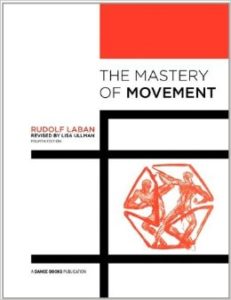 Rudolf Laban’s use of movement-based observational techniques anticipated the notion of “embodied cognition” by several decades. In his writings in the 1940s and 50s, Laban already had identified “mental efforts” — namely those of giving attention to what must be done, forming an intention to act, and finally taking decisive action — as stages of “inner preparation for outer action.”
Rudolf Laban’s use of movement-based observational techniques anticipated the notion of “embodied cognition” by several decades. In his writings in the 1940s and 50s, Laban already had identified “mental efforts” — namely those of giving attention to what must be done, forming an intention to act, and finally taking decisive action — as stages of “inner preparation for outer action.”
Laban went on to associate each of these mental efforts to one of the motion factors, according to the following scheme:
“The motion factor of Space can be associated with man’s faculty of participation with attention. The predominant tendency here is to orientate oneself and find a relationship to the matter of interest either in an immediate, direct way or in a circumspective, flexible one.”
“The motion factor of Weight can be associated with man’s faculty of participation with intention. The desire to do a certain thing may take hold of one sometimes powerfully and firmly, sometimes gently and slightly.”
“ The motion factor of Time can be associated with man’s faculty of participation with decision. Decisions can be made either unexpectedly and suddenly … or they may be developed gradually.”
Building on Laban’s correlations, Warren Lamb extended and refined the linking of movement factors with mental processes. Find out more in the next blog.

 Laban’s autobiography, A Life for Dance, is a curious book, but one that reveals a great deal about his creative vision and theatrical activities. As he notes in the letter to his publisher that opens the book:
Laban’s autobiography, A Life for Dance, is a curious book, but one that reveals a great deal about his creative vision and theatrical activities. As he notes in the letter to his publisher that opens the book: Laban wrote Mastery of Movement on the Stage (1st edition) “as an incentive to personal mobility.” And indeed, the first two chapters provide a number of explorations organized around movement themes focused on body and/or effort. Laban hopes to encourage a kind of “mobile reading,” as he explains in the Preface.
Laban wrote Mastery of Movement on the Stage (1st edition) “as an incentive to personal mobility.” And indeed, the first two chapters provide a number of explorations organized around movement themes focused on body and/or effort. Laban hopes to encourage a kind of “mobile reading,” as he explains in the Preface. Long before diversity became a political issue, Warren Lamb was encouraging diversity in management teams. His model of diversity was not based on age, race, creed, or gender. Rather it was based on decision-making style.
Long before diversity became a political issue, Warren Lamb was encouraging diversity in management teams. His model of diversity was not based on age, race, creed, or gender. Rather it was based on decision-making style. Shortly after I completed my Laban Movement Analysis training (1976), Warren Lamb gave a short course at the Dance Notation Bureau. I had been thinking a lot about the relationship between movement and psychology, but in vague and hypothetical ways. What Lamb presented was much more concrete — it blew me away.
Shortly after I completed my Laban Movement Analysis training (1976), Warren Lamb gave a short course at the Dance Notation Bureau. I had been thinking a lot about the relationship between movement and psychology, but in vague and hypothetical ways. What Lamb presented was much more concrete — it blew me away. In 2011, I participated in a pilot study examining the validity of Movement Pattern Analysis profiles in predicting decision-making patterns. Although MPA has been used by senior business teams for over 50 years, its potential application to the study of military and political leaders has barely been tapped. The pilot study was the first test of this new area of application.
In 2011, I participated in a pilot study examining the validity of Movement Pattern Analysis profiles in predicting decision-making patterns. Although MPA has been used by senior business teams for over 50 years, its potential application to the study of military and political leaders has barely been tapped. The pilot study was the first test of this new area of application. I utilized the
I utilized the  In the 1940s, Rudolf Laban took his dance theories into the world of work, addressing issues of efficiency, job satisfaction, and reduction of fatigue on the factory floor.
In the 1940s, Rudolf Laban took his dance theories into the world of work, addressing issues of efficiency, job satisfaction, and reduction of fatigue on the factory floor. As the benefits of physical motion are gaining recognition and undergoing further scrutiny, it is interesting to see how Laban characterized movement health. He wrote, “A healthy human being can have complete control of his kinesphere and dynamosphere…. The essential thing is that we should neither have preference for nor avoid certain movements because of physical or psychical restrictions.”
As the benefits of physical motion are gaining recognition and undergoing further scrutiny, it is interesting to see how Laban characterized movement health. He wrote, “A healthy human being can have complete control of his kinesphere and dynamosphere…. The essential thing is that we should neither have preference for nor avoid certain movements because of physical or psychical restrictions.” The Wall Street Journal has also been covering the health benefits of walking, notably the walk-and-talk business meeting. According to their September 13th article, “the health benefits are real for people who take walking meetings; their work gets more creative, too.”
The Wall Street Journal has also been covering the health benefits of walking, notably the walk-and-talk business meeting. According to their September 13th article, “the health benefits are real for people who take walking meetings; their work gets more creative, too.”